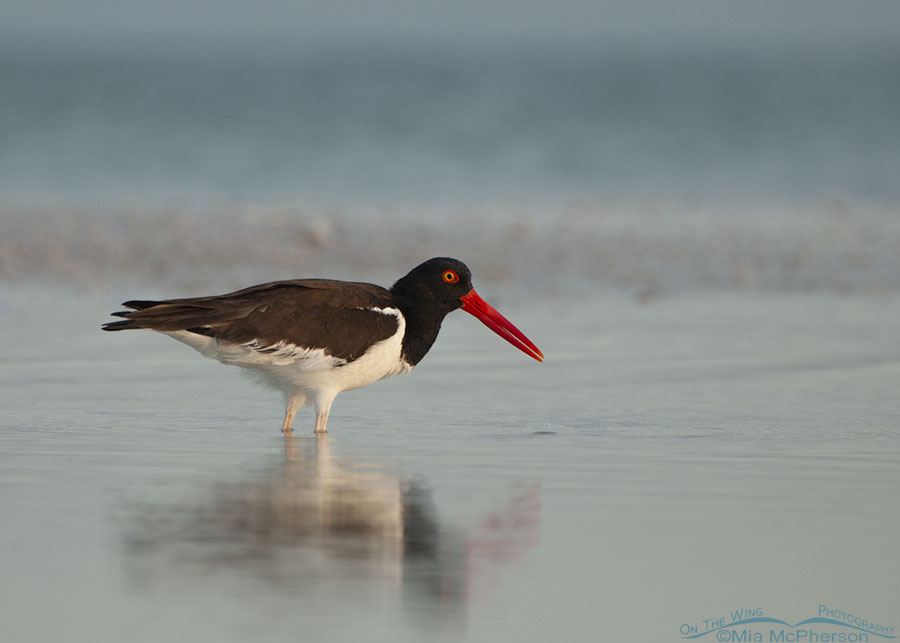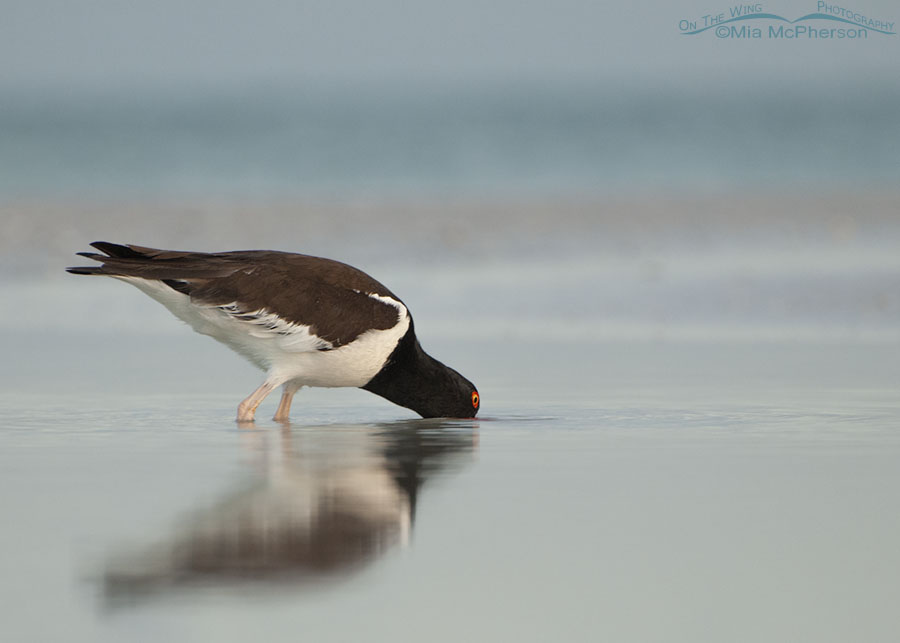 American Oystercatcher foraging in a tidal pool in the early morning – Nikon D200, handheld, f6.3, 1/350, ISO 400, Nikkor 70-300mm VR at 300mm, natural light
American Oystercatcher foraging in a tidal pool in the early morning – Nikon D200, handheld, f6.3, 1/350, ISO 400, Nikkor 70-300mm VR at 300mm, natural light
When I lived in Florida and photographed at the north beach of Fort De Soto County Park I would say that 98% of the time I arrived at the park before sunrise because I loved being at the beach when the sun came up over the horizon. I’d sit quietly waiting for sunrise and relax. Feel at peace. It was as if I watched the world wake up. I miss sitting and watching the sun come up. I’m going to have to start doing that again soon.
Right after the sun came up I would start to look for birds to photograph and almost eleven years ago my first subject of the day was a foraging American Oystercatcher. I was laying in the tidal pool with the oystercatcher when I photographed it.
My 80-400mm lens was being repaired at the time so I took my 70-300mm lens with me that morning. The birds were used to people being on the beach so I knew I would still be able to get frame filling images of my subjects.
I could have gotten closer to the oystercatcher that morning but I wanted as much of its reflection as I could get.
 American Oystercatcher foraging in the light of dawn – Nikon D200, handheld, f6.3, 1/320, ISO 400, Nikkor 70-300mm VR at 300mm, natural light
American Oystercatcher foraging in the light of dawn – Nikon D200, handheld, f6.3, 1/320, ISO 400, Nikkor 70-300mm VR at 300mm, natural light
The soft light of dawn has a special quality to it and I believe that it is evident in both of these American Oystercatcher photos. Laying in the water with the oystercatcher while it calmly moved through the water foraging? It was priceless.
Life is good. Stay safe.
Mia
American Oystercatcher facts and information:
Haematopus palliatus
- American Oystercatchers are large shorebirds with black heads, brown backs, white undersides, large red bills, yellow eyes and have pink legs with black toenails.
- There are only two species of oystercatchers in North America, Black Oystercatchers and American Oystercatchers. The American Oystercatcher has an eastern race along the Atlantic and Gulf coast and the second race on the Pacific coast.
- American Oystercatcher habitat includes beaches, mudflats, spoil islands, dunes, salt marshes and other coastal habitats. American Oystercatchers don’t go far inland.
- American Oystercatchers eat mollusks and prefer bivalves, they will occasionally consume fish. Their bill is specially adapted to prying open shells.
- American Oystercatchers can be either solitary or colonial nesters. They lay 1 to 4 eggs which take 23 to 28 days to hatch. Both sexes incubate and they are monogamous.
- Northern birds are migratory.
- A group of oystercatchers is known as a “parcel” of oystercatchers.
- American Oystercatchers can live up to 17 years.


This colorful bird is on my bucket list !! Just can’t run into one here in Rhode Island . They are here just can’t find one !!
Wow! What an interesting and colorful bird. I love how you concentrated on capturing the Oystercatchers shimmering reflection. It really works. Thanks Mia.
What a glorious start to the day.
Dawn is a few hours away here (and I won’t be greeting it lying in water) but I am very grateful you did.
Beautiful! That red beak and eye ring make each image for me! Must be really something to see in person.
Beautiful! It seems to me the light and colors are different in Florida at sunrise than in Utah. One of the groups I follow is in Florida and the soft pastel light at sunrise is more pastel pink and blue with gold. More of what I think of the Belt of Venus is. In Utah the light is more white and harsh. Maybe because sunrise in Utah has to climb higher to make it over the mountains.
I will miss all the wonderful quiet times I had walking to work in the morning in the dark and watching the morning sky slowly warm and light up. It always prepared me for the day with a peaceful mind.
Soft reflections look good and I know that seeing the bird’s bright colours like this in a photo beckons me to see it in real life. The fact that you lay down in the tidal waters to get the shot gives such an intimate point of view. Well done!
Wonderful photos, Mia
Such brilliant colours. Wow!